Publications
Patterns of depressive symptoms, drinking motives, and sexual behavior among substance using adolescents: Implications for health risk
Patterns of depressive symptoms, drinking motives, and sexual behavior among substance using adolescents: Implications for health risk
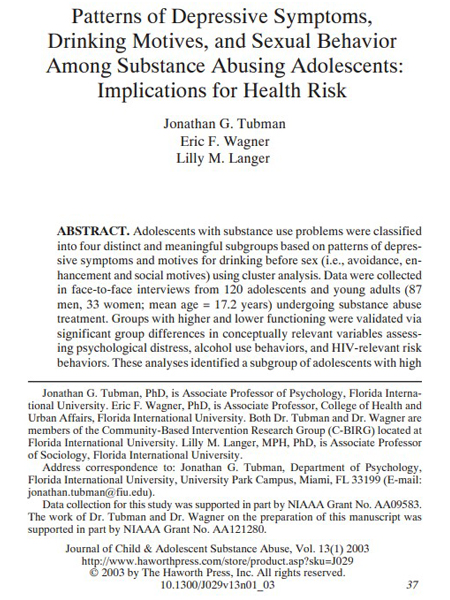 Abstract: Adolescents with substance use problems were classified into four distinct and meaningful subgroups based on patterns of depressive symptoms and motives for drinking before sex (i.e., avoidance, enhancement and social motives) using cluster analysis. Data were collected in face-to-face interviews from 120 adolescents and young adults (87 men, 33 women; mean age = 17.2 years) undergoing substance abuse treatment. Groups with higher and lower functioning were validated via significant group differences in conceptually relevant variables assessing psychological distress, alcohol use behaviors, and HIV-relevant risk behaviors. These analyses identified a subgroup of adolescents with high levels of depressive symptoms and drinking motives who are at elevated risk for HIV/STD exposure due to higher levels of risky sexual behavior and altered sexual behavior related to co-occurring alcohol use. Implications for morbidity, mortality and treatment effectiveness in this at-risk sample are discussed.
Abstract: Adolescents with substance use problems were classified into four distinct and meaningful subgroups based on patterns of depressive symptoms and motives for drinking before sex (i.e., avoidance, enhancement and social motives) using cluster analysis. Data were collected in face-to-face interviews from 120 adolescents and young adults (87 men, 33 women; mean age = 17.2 years) undergoing substance abuse treatment. Groups with higher and lower functioning were validated via significant group differences in conceptually relevant variables assessing psychological distress, alcohol use behaviors, and HIV-relevant risk behaviors. These analyses identified a subgroup of adolescents with high levels of depressive symptoms and drinking motives who are at elevated risk for HIV/STD exposure due to higher levels of risky sexual behavior and altered sexual behavior related to co-occurring alcohol use. Implications for morbidity, mortality and treatment effectiveness in this at-risk sample are discussed.
Tubman, J.G., Wagner, E.F., & Langer, L.M. (2003). Patterns of depressive symptoms, drinking motives, and sexual behavior among substance abusing adolescents: Implications for health risk. Journal of Child & Adolescent Substance Abuse, 13(1), 37-57. doi:10.1300/J029v13n01_03
Brief motivational intervention for substance-abusing delinquent adolescents: Guided Self-Change as a social work practice innovation
Brief motivational intervention for substance-abusing delinquent adolescents: Guided Self-Change as a social work practice innovation.
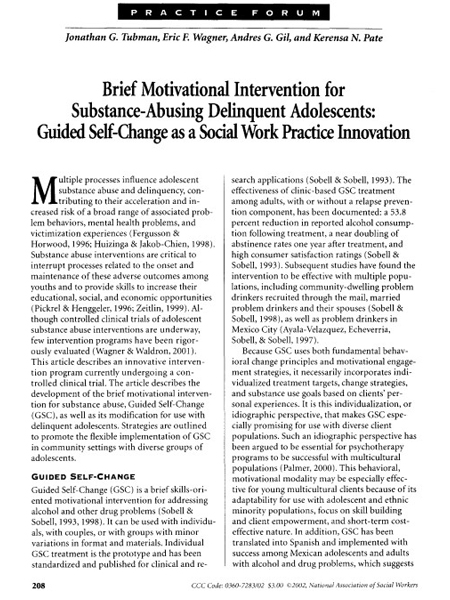 Abstract: The article presents information on brief motivational intervention for substance-abusing delinquent adolescents. Multiple processes influence adolescent substance abuse and delinquency contributing to their acceleration and increased risk of a broad range of associated problem behaviors, mental health problems, and victimization experiences. This article describes an innovative intervention program currently undergoing a controlled clinical trial. The article describes the development of the brief motivational intervention for substance abuse, Guided Self-Change (GSC), as well as its modification for use with delinquent adolescents. Strategies are outlined to promote the flexible implementation of GSC in community settings with diverse groups of adolescents. Because GSC uses both fundamental behavioral change principles and motivational engagement strategies, it necessarily incorporates individualized treatment targets, change strategies and substance use goals based on clients’ personal experiences. It is this individualization, or ideographic perspective, that makes GSC especially promising for use with diverse client populations.
Abstract: The article presents information on brief motivational intervention for substance-abusing delinquent adolescents. Multiple processes influence adolescent substance abuse and delinquency contributing to their acceleration and increased risk of a broad range of associated problem behaviors, mental health problems, and victimization experiences. This article describes an innovative intervention program currently undergoing a controlled clinical trial. The article describes the development of the brief motivational intervention for substance abuse, Guided Self-Change (GSC), as well as its modification for use with delinquent adolescents. Strategies are outlined to promote the flexible implementation of GSC in community settings with diverse groups of adolescents. Because GSC uses both fundamental behavioral change principles and motivational engagement strategies, it necessarily incorporates individualized treatment targets, change strategies and substance use goals based on clients’ personal experiences. It is this individualization, or ideographic perspective, that makes GSC especially promising for use with diverse client populations.
Tubman, J.G., Wagner, E.F., Gil, A.G., & Pate, K.N. (2002). Brief motivational intervention for substance-abusing delinquent adolescents: Guided Self-Change as a social work practice innovation. Health & Social Work, 27(3), 208. doi:10.1093/hsw/27.3.208
Understanding and treating juvenile offenders: A review of current knowledge and future directions
Understanding and treating juvenile offenders: A review of current knowledge and future directions
 Abstract: Juvenile delinquency is one of our most pressing social problems, with negative emotional, physical, and economic effects felt throughout society. Considering the prevalence, stability, and detrimental impact of juvenile offending, the development of effective treatments is of utmost importance. This article provides an overview of available evidence regarding several key issues pertaining to treatment for juvenile offenders. First, the etiology, continuity, and long-term consequences of juvenile offending are reviewed. Second, factors associated with treatment outcome are discussed. Third, information regarding the most commonly used intervention strategies are provided. These strategies include family/systems, parent and social skills training, cognitive–behavioral, peer group counseling, wilderness programs, and boot camps. Finally, gaps in knowledge, research implications, and future directions are presented.
Abstract: Juvenile delinquency is one of our most pressing social problems, with negative emotional, physical, and economic effects felt throughout society. Considering the prevalence, stability, and detrimental impact of juvenile offending, the development of effective treatments is of utmost importance. This article provides an overview of available evidence regarding several key issues pertaining to treatment for juvenile offenders. First, the etiology, continuity, and long-term consequences of juvenile offending are reviewed. Second, factors associated with treatment outcome are discussed. Third, information regarding the most commonly used intervention strategies are provided. These strategies include family/systems, parent and social skills training, cognitive–behavioral, peer group counseling, wilderness programs, and boot camps. Finally, gaps in knowledge, research implications, and future directions are presented.
Tarolla, S.M., Wagner, E.F., Rabinowitz, J., & Tubman, J.G. (2002). Understanding and treating juvenile offenders: A review of current knowledge and future directions. Aggression & Violent Behavior, 7(2), 125. doi:10.1016/S1359-1789(00)00041-0
Amenability and implementation in secondary school antitobacco programs
Amenability and implementation in secondary school antitobacco programs
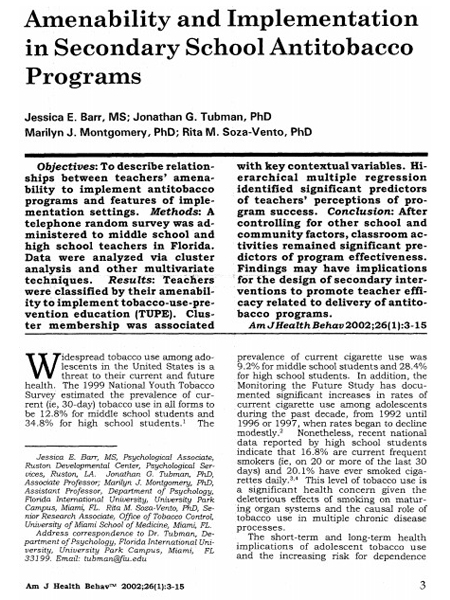 Abstract: To describe relationships between teachers’ amenability to implement antitobacco programs and features of implementation settings. A telephone random survey was administered to middle school and high school teachers in Florida. Data were analyzed via cluster analysis and other multivariate techniques. Teachers were classified by their amenability to implement tobacco-use-prevention education (TUPE). Cluster membership was associated with key contextual variables. Hierarchical multiple regression identified significant predictors of teachers’ perceptions of program success. After controlling for other school and community factors, classroom activities remained significant predictors of program effectiveness. Findings may have implications for the design of secondary interventions to promote teacher efficacy related to delivery of antitobacco programs.
Abstract: To describe relationships between teachers’ amenability to implement antitobacco programs and features of implementation settings. A telephone random survey was administered to middle school and high school teachers in Florida. Data were analyzed via cluster analysis and other multivariate techniques. Teachers were classified by their amenability to implement tobacco-use-prevention education (TUPE). Cluster membership was associated with key contextual variables. Hierarchical multiple regression identified significant predictors of teachers’ perceptions of program success. After controlling for other school and community factors, classroom activities remained significant predictors of program effectiveness. Findings may have implications for the design of secondary interventions to promote teacher efficacy related to delivery of antitobacco programs.
Barr, J.E., Tubman, J.G., Montgomery, M.J., & Soza-Vento, R.M. (2002). Amenability and implementation in secondary school antitobacco programs. American Journal of Health Behavior, 26(1), 3-15. doi:10.5993/ajhb.26.1.1
Substance abuse interventions with Latino adolescents: A cultural framework
Substance abuse interventions with Latino adolescents: A cultural framework
 Abstract: This chapter presents a cultural framework for the development of effective substance abuse interventions for Latino youth. The conceptual background and rationale for interventions with Latino youth are presented, and cultural factors relevant to the implementation of interventions are discussed. We conclude with a description of a brief intervention for alcohol and drug abuse for use with juvenile justice populations and tailored to meet the specific needs and life circumstances of Latino adolescents and their families.
Abstract: This chapter presents a cultural framework for the development of effective substance abuse interventions for Latino youth. The conceptual background and rationale for interventions with Latino youth are presented, and cultural factors relevant to the implementation of interventions are discussed. We conclude with a description of a brief intervention for alcohol and drug abuse for use with juvenile justice populations and tailored to meet the specific needs and life circumstances of Latino adolescents and their families.
Gil, A.G., Tubman, J.G., & Wagner, E.F. (2001). Substance abuse interventions with Latino adolescents: A cultural framework. Innovations in Adolescent Substance Abuse Interventions, 353-378. doi:10.1016/b978-008043577-0/50036-5
Coerced sexual experiences among adolescent substance abusers: A potential pathway to increased vulnerability to HIV exposure
Coerced sexual experiences among adolescent substance abusers: A potential pathway to increased vulnerability to HIV exposure
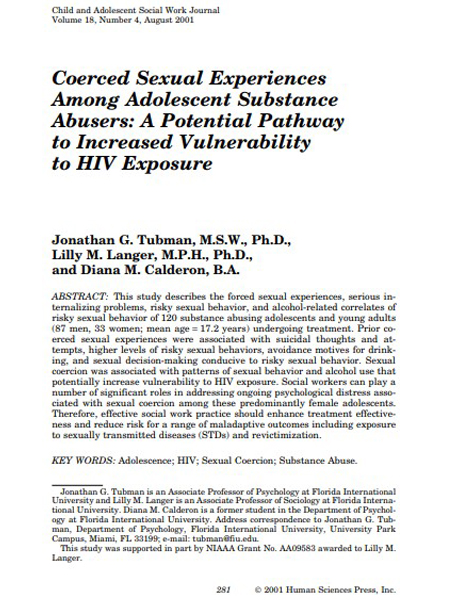 Abstract: This study describes the forced sexual experiences, serious internalizing problems, risky sexual behavior, and alcohol-related correlates of risky sexual behavior of 120 substance abusing adolescents and young adults (87 men, 33 women; mean age = 17.2 years) undergoing treatment. Prior coerced sexual experiences were associated with suicidal thoughts and attempts, higher levels of risky sexual behaviors, avoidance motives for drinking, and sexual decision-making conducive to risky sexual behavior. Sexual coercion was associated with patterns of sexual behavior and alcohol use that potentially increase vulnerability to HIV exposure. Social workers can play a number of significant roles in addressing ongoing psychological distress associated with sexual coercion among these predominantly female adolescents. Therefore, effective social work practice should enhance treatment effectiveness and reduce risk for a range of maladaptive outcomes including exposure to sexually transmitted diseases (STDs) and revictimization.
Abstract: This study describes the forced sexual experiences, serious internalizing problems, risky sexual behavior, and alcohol-related correlates of risky sexual behavior of 120 substance abusing adolescents and young adults (87 men, 33 women; mean age = 17.2 years) undergoing treatment. Prior coerced sexual experiences were associated with suicidal thoughts and attempts, higher levels of risky sexual behaviors, avoidance motives for drinking, and sexual decision-making conducive to risky sexual behavior. Sexual coercion was associated with patterns of sexual behavior and alcohol use that potentially increase vulnerability to HIV exposure. Social workers can play a number of significant roles in addressing ongoing psychological distress associated with sexual coercion among these predominantly female adolescents. Therefore, effective social work practice should enhance treatment effectiveness and reduce risk for a range of maladaptive outcomes including exposure to sexually transmitted diseases (STDs) and revictimization.
Tubman, J.G., Langer, L.M., & Calderon, D.M. (2001). Coerced sexual experiences among adolescent substance abusers: A potential pathway to increased vulnerability to HIV exposure. Child and Adolescent Social Work Journal, 18(4), 281-303. doi:10.1023/a:1010989001086
The relationship between thought suppression and smoking cessation
The relationship between thought suppression and smoking cessation
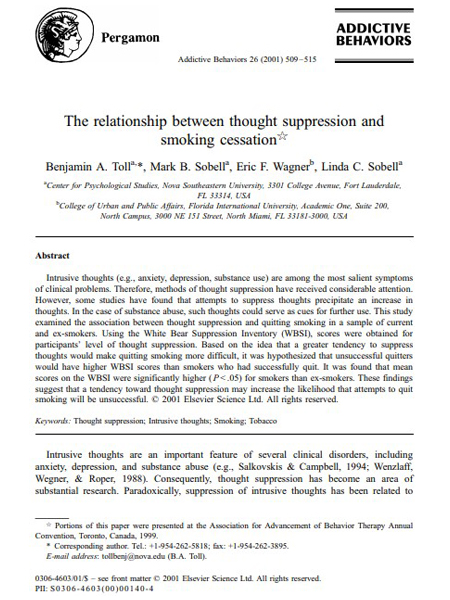 Abstract: Intrusive thoughts (e.g., anxiety, depression, substance use) are among the most salient symptoms of clinical problems. Therefore, methods of thought suppression have received considerable attention. However, some studies have found that attempts to suppress thoughts precipitate an increase in thoughts. In the case of substance abuse, such thoughts could serve as cues for further use. This study examined the association between thought suppression and quitting smoking in a sample of current and ex-smokers. Using the White Bear Suppression Inventory (WBSI), scores were obtained for participants’ level of thought suppression. Based on the idea that a greater tendency to suppress thoughts would make quitting smoking more difficult, it was hypothesized that unsuccessful quitters would have higher WBSI scores than smokers who had successfully quit. It was found that mean scores on the WBSI were significantly higher (P<.05) for smokers than ex-smokers. These findings suggest that a tendency toward thought suppression may increase the likelihood that attempts to quit smoking will be unsuccessful.
Abstract: Intrusive thoughts (e.g., anxiety, depression, substance use) are among the most salient symptoms of clinical problems. Therefore, methods of thought suppression have received considerable attention. However, some studies have found that attempts to suppress thoughts precipitate an increase in thoughts. In the case of substance abuse, such thoughts could serve as cues for further use. This study examined the association between thought suppression and quitting smoking in a sample of current and ex-smokers. Using the White Bear Suppression Inventory (WBSI), scores were obtained for participants’ level of thought suppression. Based on the idea that a greater tendency to suppress thoughts would make quitting smoking more difficult, it was hypothesized that unsuccessful quitters would have higher WBSI scores than smokers who had successfully quit. It was found that mean scores on the WBSI were significantly higher (P<.05) for smokers than ex-smokers. These findings suggest that a tendency toward thought suppression may increase the likelihood that attempts to quit smoking will be unsuccessful.
Toll, B.A., Sobell, M.B., Wagner, E.F., & Sobell, L.C. (2001). The relationship between thought suppression and smoking cessation. Addictive Behaviors, 26(4), 509-515. doi:10.1016/s0306-4603(00)00140-4
Book review: Alcohol use among adolescents
Practical and methodological challenges in validating community-based interventions
Practical and methodological challenges in validating community-based interventions
 Abstract: Practical and methodological challenges in conducting research on community-based interventions for adolescent problems are described. First, a conceptual framework for the development of community-based interventions is provided, with an emphasis on the ecological and commonweal advantages of such interventions. Next, important issues that investigators confront when pursuing the dual goals of providing good community-based intervention and conducting rigorous intervention research are addressed. These issues include research design, intervention specification and integrity, participant concerns, changing clinical culture, community challenges, school challenges, and appropriate staffing. Finally, a summary of challenges to conducting good community-based intervention research and effective responses to these challenges is presented.
Abstract: Practical and methodological challenges in conducting research on community-based interventions for adolescent problems are described. First, a conceptual framework for the development of community-based interventions is provided, with an emphasis on the ecological and commonweal advantages of such interventions. Next, important issues that investigators confront when pursuing the dual goals of providing good community-based intervention and conducting rigorous intervention research are addressed. These issues include research design, intervention specification and integrity, participant concerns, changing clinical culture, community challenges, school challenges, and appropriate staffing. Finally, a summary of challenges to conducting good community-based intervention research and effective responses to these challenges is presented.
Wagner, E.F., Swenson, C.C., & Henggeler, S.W. (2000). Practical and methodological challenges in validating community-based interventions. Children’s Services: Social Policy, Research & Practice, 3(4), 211-231. doi:10.1207/S15326918CS0304_2
Acculturation, familism, and alcohol use among Latino adolescent males: Longitudinal relations
Acculturation, familism, and alcohol use among Latino adolescent males: Longitudinal relations
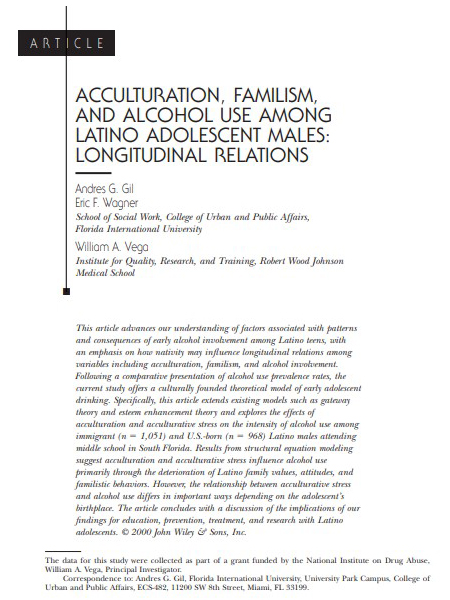 Abstract: This article advances our understanding of factors associated with patterns and consequences of early alcohol involvement among Latino teens, with an emphasis on how nativity may influence longitudinal relations among variables including acculturation, familism, and alcohol involvement. Following a comparative presentation of alcohol use prevalence rates, the current study offers a culturally founded theoretical model of early adolescent drinking. Specifically, this article extends existing models such as gateway theory and esteem enhancement theory and explores the effects of acculturation and acculturative stress on the intensity of alcohol use among immigrant (n= 1,051) and U.S.-born (n= 968) Latino males attending middle school in South Florida. Results from structural equation modeling suggest acculturation and acculturative stress influence alcohol use primarily through the deterioration of Latino family values, attitudes, and familistic behaviors. However, the relationship between acculturative stress and alcohol use differs in important ways depending on the adolescent’s birthplace. The article concludes with a discussion of the implications of our findings for education, prevention, treatment, and research with Latino adolescents. © 2000 John Wiley & Sons, Inc.
Abstract: This article advances our understanding of factors associated with patterns and consequences of early alcohol involvement among Latino teens, with an emphasis on how nativity may influence longitudinal relations among variables including acculturation, familism, and alcohol involvement. Following a comparative presentation of alcohol use prevalence rates, the current study offers a culturally founded theoretical model of early adolescent drinking. Specifically, this article extends existing models such as gateway theory and esteem enhancement theory and explores the effects of acculturation and acculturative stress on the intensity of alcohol use among immigrant (n= 1,051) and U.S.-born (n= 968) Latino males attending middle school in South Florida. Results from structural equation modeling suggest acculturation and acculturative stress influence alcohol use primarily through the deterioration of Latino family values, attitudes, and familistic behaviors. However, the relationship between acculturative stress and alcohol use differs in important ways depending on the adolescent’s birthplace. The article concludes with a discussion of the implications of our findings for education, prevention, treatment, and research with Latino adolescents. © 2000 John Wiley & Sons, Inc.
Gil, A.G., Wagner, E.F., & Vega, W.A. (2000). Acculturation, familism, and alcohol use among Latino adolescent males: Longitudinal relations. Journal of Community Psychology, 28(4), 443-458. doi:10.1002/1520-6629(200007)28:4<443::AID-JCOP6>3.0.CO;2-A

